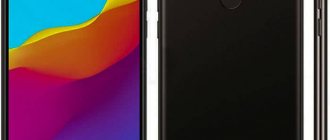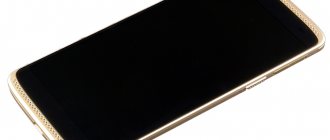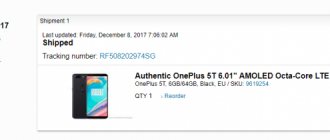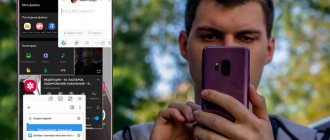Many manufacturers began releasing smartphones with notches on the screen after Apple did it with the iPhone X in 2020. One of such manufacturers is the Chinese company Vivo. One of the smartphones from this company this fall was the V11.
It was this manufacturer that was the first to introduce an in-screen fingerprint scanner. Now the company is trying to promote this technology into mid-price devices.
This makes the Vivo V11 a pretty interesting proposition. This is not a flagship, but rather a mid-priced smartphone. Despite this, it has not one, but two distinctive features. The glass design attracts the eye, especially the screen with a small cutout at the top.
Vivo V11 smartphone
Despite the fact that this smartphone does not belong to the X line, it has quite interesting characteristics. It uses a Snapdragon 660 processor with artificial intelligence algorithms, a large amount of RAM and storage, a dual rear camera and a front camera with the ability to shoot in high resolution.
Specifications
| Size: | 157.9 x 75 x 7.9 mm; |
| Weight: | 156; |
| RAM: | 6 GB; |
| Built-in memory: | 128 GB; |
| Memory card: | microSD; |
| Display: | Super AMOLED 6.41″ 2340×1080 pixels (19.5:9), 402ppi; |
| CPU: | Snapdragon 660 chipset – octa-core (4×2.2 GHz Kryo 260 & 4×1.8 GHz Kryo 260), Adreno 512 GPU; |
| Camera: | Main – 12 MP (f/1.8) + 5 MP; Front - 25 MP, (f/2.0), 1080p video; |
| Battery: | 3400 mAh, fast charging (18 W); |
| Other: | microUSB (USB 2.0); Bluetooth 5.0; GPS; GLONASS; 3.5 mm headphone jack; on-screen scanner; FM radio; |
| OS: | Android 8.1 with Funtouch v4.5 shell; |
Video review:
Specifications
Unfortunately, Vivo, like the Chinese company Oppo, still forces us to endure the outdated microUSB connector. Of course, the flagship smartphone Vivo Nex S works with USB-C, but in this case you have to make do with an outdated interface. It is possible that this may cause some people to have problems connecting peripheral devices.
Another distinctive feature of smartphones in 2020 is their iridescent housings. Here this characteristic is presented in full. This review examines the color variant of the smartphone called “Starry Night” with tints between black and blue.
Communication and sound
In terms of multimedia capabilities, everything is as simple as possible here. It has its own music player with a built-in equalizer, the audio chip is completely simple, and the sound is flat in places.
The auditory speaker, as in other smartphones of the company, is excellent, beyond praise. There is only one polyphonic speaker here, it has sufficient volume, but poor quality; for Vivo, good speakers in budget and mid-price segment smartphones have not yet been reached.
Design
Vivo V11 has a combination of glass on both sides. All modern smartphones these days and even many devices in the mid-price category can boast of this. However, here the developers tried to stand out from the crowd.
Firstly, an AMOLED panel is used. The diagonal is quite large and is 6.41 inches. Thanks to the very thin bezels around the screen, the device does not feel large. The small cutout houses the 25MP front camera and nothing else. Of course, it still interferes with the uninterrupted view of the screen, but not as much as larger cutouts. Some would even say that this cutout gives the device its own look.
If you look closely, you will see a long telephone shell grille on the frame. There are several smartphones that promise an edge-to-edge screen. The Halo FullView panel comes as close as possible to this title. The width of the frames on the side is only 1.76 mm, on the top 3 mm.
The fingerprint scanner is located inside the screen. This is the second distinctive feature of this smartphone. Vivo was the first among all manufacturers in the world to introduce such a scanner, and now it is also available in a mid-priced device. The scanner is always on, so you can see a small pointer on the screen where to place your finger. However, it can be turned off so as not to waste extra energy.
If you do not use the scanner to unlock your smartphone, you need to use the power button to activate it and only then use the sensor. It's not the fastest process, but you can use face unlock instead.
The back side looks gorgeous. Available in two color options, this review is looking at the blue and black combination. Another version displays light blue stars scattered throughout the body.
The dual rear camera protrudes from the body. The main sensor is 12 MP, another 5 MP is responsible for image depth. You will see a gold edging around the camera module.
The back surface is glass, although the specific type of glass is not named. It is unlikely that this device will survive a fall on the asphalt, so it is recommended to wear a case. In addition, the case quickly collects scratches. Its edges are traditionally curved, which makes the device quite narrow, but worsens the grip.
The frame is plastic and has a glossy, slippery finish. The thin and curved shape makes the device particularly slippery.
On the bottom edge there is a 3.5 mm headphone jack, which will come in handy for some. There is a compartment for three cards, two SIM cards and one microSD memory card.
The case dimensions are 157.9 x 75 x 7.9 mm and it weighs 156 g.
Overall, the Vivo V11 looks great. Glass smartphones are all the rage right now, as are AMOLED screens with notches. The fingerprint scanner inside the screen makes the device quite innovative.
Vivo V11 smartphone review
Vivo, after the conceptual and not entirely mass-produced Nex, released a pair of quite ordinary mid-level smartphones, the V11 and V11i. These twin smartphones are similar in many ways, but the presence of the Qualcomm Snapdragon platform in the V11, as opposed to the MediaTek Helio in the V11i, definitely makes the first a much more interesting product in all respects, although it costs a little more. Today we will look at Vivo V11 in detail.
Key Features of Vivo V11 (vivo model 1804)
- SoC Qualcomm Snapdragon 660, 4 cores Kryo 260 @ 2.2 GHz + 4 cores Kryo 260 @ 1.8 GHz
- GPU Adreno 512
- Operating system Android 8.1, Funtouch OS 4.5
- Touch display Super AMOLED 6.41″, 2340×1080 (19.5:9)
- Random access memory (RAM) 6 GB, internal memory 128 GB
- MicroSD support up to 256 GB
- Nano-SIM support (2 pcs.)
- Networks GSM/WCDMA/LTE (Cat.12) FDD B1/3/7/8/20, TDD B38/40/41
- Wi-Fi 802.11a/b/g/n (2.4/5 GHz)
- Bluetooth 5.0
- No NFC
- GPS, A-GPS, Glonass, Beidou
- Micro-USB, USB OTG
- 3.5 mm headphone audio output
- Main camera 12 + 5 MP (f/1.8 + f/2.4), autofocus, 4K video
- Front camera 25 MP, f/2.0
- Proximity and light sensors, compass, accelerometer
- Fingerprint's scanner
- Battery 3400 mAh, fast charging
- Dimensions 158×75×7.9 mm
- Weight 156 g
| average price | find out prices |
| Retail offers | find out the price |
Appearance and ease of use
The design of Vivo V11 is typical for the latest generation of Vivo and Oppo smartphones: noticeably thinner side edges are the main difference from most other mobile products on the market. This is not to say that this is a clear advantage: the strongly pointed sides leave too little contact surface with the palm; the smartphone literally rolls in your hands, especially considering the extremely smooth and slippery surfaces of its plastic body.
The front panel is also “cutting-edge”: the second generation of the notch-notch, invented by Apple, “mutated” in the hands of Chinese designers to a small semicircle (and was called “teardrop-shaped”), containing, in fact, only the front camera. The remaining frame around the screen is minimal: the display occupies 91.3% of the front panel area. The speaker is placed upstairs, at the junction of the display glass and the case.
The surface of the lacquered plastic back cover is smooth and easily soiled; it is necessary to constantly wipe off fingerprints from it or use a case. But there is also an undeniable advantage: the smartphone is lightweight compared to the average modern “full-screen” mobile device weighing 180 g or more. Here, the thin and light body weighs just over 150 g, and the smartphone does not weigh down your trouser pockets.
The front 2.5D glass already has a good quality factory protective film with a cutout for the front camera. The film is good quality, there is no point in tearing it off.
The camera module on the back side protrudes slightly outward, but this generally does not prevent the smartphone from lying stable on the table. Considering that the fingerprint scanner has finally begun to move back to the front panel in new models (here it is directly under the glass), using a smartphone lying on the table has become quite comfortable.
The flash is single, small, not very bright. By the way, this is the case when the flashlight is called up with a gesture not from the top, like all Android smartphones, but from the bottom, like the iPhone.
There is no LED event indicator installed on the front panel, but the charging status is displayed even when the screen is turned off.
There are no touch buttons or a fingerprint scanner under the screen - more precisely, the scanner is installed under the plane of the screen. If you look at the smartphone in portrait position, then at the bottom there is only a narrow strip of empty space, against which the strongly rounded corners of the display itself stand out well. According to the new fashion, each developer began to install an alternative control method in their smartphones: here, instead of the three usual Android navigation buttons, you can bring up three thin stripes on the screen and control everything using gestures.
The side keys are small, protrude weakly from the body, have no tactile feel and do not differ in texture. Finding the buttons by touch is difficult, this is far from the best option.
The card slot is not hybrid; you can simultaneously install two Nano-SIM cards and one memory card. Hot swapping of cards is supported.
At the top end there is only an additional microphone, nothing else.
At the bottom end, the USB port is represented by a Micro-USB connector, not a Type-C connector, which is very strange. Still, the model is not a budget one, and in general - how long can it be? But the fact that the manufacturer has retained a 3.5 mm headphone output cannot but rejoice. The main speaker and conversational microphone are also located here, at the bottom end.
The Vivo V11 comes in three gradient colours: Starry Night, Nebula and Gold - the latter, however, will only be sold in India. The hull did not receive protection from water.
Screen
Vivo V11 features a Super AMOLED display with 2.5D glass protection. The screen dimensions are approximately 68x148 mm with a diagonal of 6.41 inches, the resolution is 2340x1080 (aspect ratio 19.5:9), which gives a pixel density of about 402 ppi. The width of the frame on the sides is 3 mm, the margin at the bottom is 5 mm, at the top is 4 mm.
You can adjust the display brightness manually or use automatic settings based on the ambient light sensor. Multi-touch tests diagnose support for 10 simultaneous touches.
A detailed examination using measuring instruments was carried out by the editor of the “Monitors” and “Projectors and TV” sections Alexey Kudryavtsev . Here is his expert opinion on the screen of the sample under study.
The front surface of the screen is made in the form of a glass plate with a mirror-smooth surface that is scratch-resistant. Judging by the reflection of objects, the anti-glare properties of the screen are better than those of the Google Nexus 7 (2013) screen (hereinafter simply Nexus 7). For clarity, here is a photo in which a white surface is reflected in the switched off screens (on the left - Nexus 7, on the right - Vivo V11, then they can be distinguished by size):
The screen of the Vivo V11 is slightly darker (brightness according to photographs is 117 versus 119 for the Nexus 7). The ghosting of reflected objects in the Vivo V11 screen is very weak, which indicates that there is no air gap between the layers of the screen. Due to the smaller number of boundaries (glass/air type) with very different refractive indices, such screens look better in conditions of intense external illumination, but their repair in the case of cracked external glass is much more expensive, since the entire screen has to be replaced. The outer surface of the screen has a special oleophobic (grease-repellent) coating (better in efficiency than that of the Nexus 7), so fingerprints are removed more easily and appear at a slower rate than with regular glass.
When displaying the white field in full screen and manually controlling the brightness, its maximum value was 410 cd/m² in normal conditions, and in very bright light it rises to 530 cd/m². You also need to take into account the fact that in this case, the smaller the white area on the screen, the brighter it is, that is, the actual maximum brightness of the white areas will almost always be higher than the specified value. As a result, screen readability during the day in the sun should be at a good level. The minimum value is 2.5 cd/m², that is, the reduced brightness level allows you to use the device even in complete darkness without any problems. Automatic brightness adjustment works based on the light sensor (it is located under the screen to the left of the front camera). The operation of this function depends on the position of the brightness adjustment slider; the user can use it to try to set the desired brightness level in the current conditions. If you leave everything at default, then in complete darkness the auto-brightness function reduces the brightness to 2.5 cd/m² (a little dark), in an office illuminated by artificial light (approximately 550 lux) it sets it to 70 cd/m² (it could be brighter), in in a very bright environment (corresponding to lighting on a clear day outdoors, but without direct sunlight - 20,000 lux or a little more) increases to 530 cd/m² (to the maximum, as needed). We were not entirely satisfied with the result, so in complete darkness we slightly increased the brightness, resulting in the following values for the three conditions indicated above: 20, 105 and 530 cd/m² (ideal combination). It turns out that the auto-brightness function works adequately and allows you to customize your work to individual requirements.
At any brightness level there is significant modulation with a frequency of 60 or 240 Hz. The figure below shows brightness (vertical axis) versus time (horizontal axis) for several brightness settings:
It can be seen that at maximum (as “100%++” we designated the mode with additional illumination of the light sensor with bright light) and average brightness, the modulation amplitude is not very large, as a result there is no visible flicker. However, with a strong decrease in brightness, modulation appears with a large relative amplitude; its presence can already be seen in a test for the presence of a stroboscopic effect or simply with rapid eye movement. Depending on individual sensitivity, this flickering may cause increased fatigue.
This screen uses a Super AMOLED matrix - an active matrix on organic light-emitting diodes. A full-color image is created using subpixels of three colors - red (R), green (G) and blue (B), but there are half as many red and blue subpixels, which can be referred to as RGBG. This is confirmed by a fragment of a microphotograph:
For comparison, you can see the gallery of microphotographs of screens used in mobile technology.
In the fragment above you can count 4 green subpixels, 2 red (4 halves) and 2 blue (1 whole and 4 quarters), and by repeating these fragments, you can lay out the entire screen without breaks or overlap. For such matrices, Samsung introduced the name PenTile RGBG. The manufacturer calculates the screen resolution based on the green subpixels; based on the other two, it will be two times lower. Of course, there is some unevenness of contrast borders and other artifacts. However, due to the high resolution, they only minimally affect the image quality.
The screen has excellent viewing angles. True, the white color, when deviated even at small angles, alternately acquires a barely visible blue-green and pinkish tint, but the black color remains simply black at any angle. It is so black that the contrast setting is not applicable in this case. For comparison, here are photographs in which the same images are displayed on the screens of Vivo V11 and Nexus 7, while the screen brightness is initially set to approximately 200 cd/m², and the color balance on the camera is forced to switch to 6500 K.
There is a white field perpendicular to the screens:
The uniformity of brightness and color tone of the white field is very good.
And a test picture:
The colors on the Vivo V11's screen are oversaturated (note the tomatoes, bananas, napkin and face shade) and the color balance is different. Let us remind you that the photograph cannot serve as a reliable source of information about the quality of color rendering and is provided only for conditional visual illustration. In particular, the pronounced reddish tint of the white and gray fields present in photographs of the Vivo V11 screen is visually absent when viewed perpendicularly, as confirmed by hardware tests using a spectrophotometer. The reason is that the spectral sensitivity of the camera sensor does not exactly match this characteristic of human vision.
Now at an angle of approximately 45 degrees to the plane and to the side of the screen. White field:
The brightness at an angle for both screens has noticeably decreased (to avoid strong darkening, the shutter speed has been increased compared to previous photos), but in the case of the Vivo V11 the drop in brightness is less. As a result, with formally the same brightness, the Vivo V11 screen visually looks much brighter (compared to LCD screens), since you often have to look at the screen of a mobile device from at least a slight angle.
And a test picture:
It can be seen that the colors have not changed much on both screens and the brightness of the Vivo V11 at an angle is noticeably higher.
Switching the state of the matrix elements is almost instantaneous, but at the turn-on edge there may be a step with a width of approximately 17 ms (which corresponds to a screen refresh rate of approximately 60 Hz). For example, this is what the dependence of brightness on time looks like when moving from black to white and back:
In some conditions, the presence of such a step can lead to plumes trailing behind moving objects. However, dynamic scenes in films on OLED screens are distinguished by high clarity and even some “jerky” movements. The graph above shows how after a few tens of milliseconds the brightness begins to decrease when white is displayed in full screen.
A gamma curve constructed using 32 points with equal intervals based on the numerical value of the shade of gray showed that there is no significant blockage either in the highlights or in the shadows. The exponent of the approximating power function is 2.08, which is slightly lower than the standard value of 2.2. In this case, the real gamma curve deviates slightly from the power-law dependence:
Let us recall that in the case of OLED screens, the brightness of image fragments dynamically changes in accordance with the nature of the displayed image - it decreases for generally light images. As a result, the resulting dependence of brightness on hue (gamma curve) most likely slightly does not correspond to the gamma curve of a static image, since the measurements were carried out with sequential display of shades of gray on almost the entire screen.
The color gamut is much wider than sRGB, it is almost equal to DCI-P3:
The spectra of the components are very well separated, which allows for wide coverage:
Note that on screens with a wide color gamut, without appropriate correction, the colors of regular images optimized for sRGB devices appear unnaturally saturated.
Of course, there is a mode with reduced intensity of the blue component:
Let us recall that, in principle, bright light can lead to disruption of the daily (circadian) rhythm (see the article about the iPad Pro with a 9.7-inch display), but everything can be solved by adjusting the brightness to a comfortable level, and distorting the color balance, reducing the contribution of blue , makes absolutely no sense.
The default color temperature for white and gray fields is high, around 8000K, but the above setting can be used to adjust the color temperature. After correction, the balance becomes better: the color temperature is closer to 6500 K, while in a significant portion of the gray scale this parameter does not change very much, which improves the visual perception of color balance. The deviation from the blackbody spectrum (ΔE) remains below 10 units, which is considered a good indicator for a consumer device:
(The darkest areas of the gray scale can be ignored, since color balance there is not very important, and the error in measuring color characteristics at low brightness is large.)
Let's summarize. The screen has a very high maximum brightness and has excellent anti-glare properties, so the device can be used outdoors even on a sunny summer day. In complete darkness, the brightness can be reduced to a comfortable value. It is acceptable to use a mode with automatic brightness adjustment, which works adequately. The advantages of the screen include an effective oleophobic coating and good color balance (after a small correction). At the same time, let us recall the general advantages of OLED screens: true black color (if nothing is reflected in the screen), good uniformity of the white field, noticeably less than that of LCDs, and a drop in image brightness when viewed at an angle. Disadvantages include an overly wide color gamut and screen flickering at low brightness. For users who are particularly sensitive to flicker, this may cause increased fatigue. However, overall the screen quality is high.
Cameras
Vivo V11 uses one module as a front camera, but with a high-resolution 25 MP sensor and an f/2.0 aperture lens. The shooting quality is decent: there are no complaints about detail (if you reduce the resolution of the images to some reasonable level) or about color rendition. Naturally, there is a wide range of tools for retouching and makeup - skin whitening, changing the shape of the face, even some kind of “polishing” - all this is not for everyone.
The rear camera consists of two modules. The main one has a sensor with a resolution of 24 megapixels (pixel size is 1.28 microns, Dual Pixel technology is used, so the resulting image resolution is 12 megapixels) and a lens with an f/1.8 aperture. An additional module with a 5 MP sensor resolution and an f/2.4 aperture lens is needed for portrait mode with background blur (here it is directly called: “Beautiful face using AI”). There is no optical stabilization, the flash is not very bright, and autofocus is very fast.
Artificial intelligence (AI) determines scenic situations (Food, Portrait, Flowers, etc.), adjusting settings to the shooting conditions, controls HDR modes, portrait mode, as well as a special night mode, in which it takes up to six pictures, then combining them into one . There is a manual settings mode, but there is no standard ability to save images in RAW.
Examples of shooting with the main camera:
The use of Dual Pixel technology benefits the camera, it focuses faster, and the pictures come out with lower resolution (trying to chase detail on typical smartphone matrices is still doomed to failure), so there are fewer complaints about them when viewed at full size, while the noise level below. There is still noise in the pictures, and the camera still struggles with it, it just looks better than budget smartphones that resort to scorched sky tactics during the day and smear a mess of pixels across the frame plate at night. At the same time, we can’t say that the Vivo V11 takes really good pictures (not to mention flagship ones). The camera still doesn’t provide any detail even at 12 megapixels, there’s not enough sharpness, the grass and foliage blend together, and the image gets a little blurry towards the edges of the frame.
The situation with night shots (and generally low-light shots) is interesting. The stated work of AI is obvious here, taking several pictures and then “gluing” them together into one. The result is frames with almost daylight lighting, preserving the beautiful night illumination of buildings (if there is something to save, of course). However, for the full operation of this algorithm, it seems that an image stabilizer is required (preferably optical), because otherwise a “blur” effect occurs in the pictures. And yet this is a very, very good result, which is not spoiled even by the noise presented here by unstraining monochrome ripples. In terms of the quality of night photography, the smartphone, if not up to par with flagships, is at least significantly superior to the mid-range and budget sector (whose representatives shoot equally poorly in the dark).
The main camera can shoot video in a maximum resolution of 4K at 30 fps, there is no optical stabilization. And yet, the camera produces a picture that is quite good in terms of sharpness and brightness, the detail is also high, the focus is adequate - it does not jump. Everything is fine with the sound: it is recorded cleanly and clearly, the sound is bright and loud, and no distortion from the noise reduction system was noticed.
Video examples:
- Video No. 1 (64 MB, 3840× [email protected] fps, H.264, AAC)
- Video No. 2 (71 MB, 3840× [email protected] fps, H.264, AAC)
- Video No. 3 (135 MB, 3840× [email protected] fps, H.264, AAC)
- Video No. 4 (60 MB, 3840× [email protected] fps, H.264, AAC)
- Video No. 5 (27 MB, 1920× [email protected] fps, H.264, AAC)
Telephone and communications
The Snapdragon 660 chipset includes an X12 LTE modem, which provides data download speeds of up to 600 Mbps. The smartphone can support multiple LTE Cat.12 FDD (B1/3/7/8/20) and TDD (B38/40/41) frequency bands. There are no complaints about working in wireless networks: within the city limits of the Moscow region, the device behaves confidently, maintains a 4G network, and quickly restores communication after a forced interruption.
Both Wi-Fi bands (2.4 and 5 GHz) are supported, plus the 802.11ac standard, as well as Bluetooth 5.0. But the Chinese manufacturer, of course, does not offer an NFC module to its users, which is a pity.
The navigation module works with GPS (with A-GPS), Glonass and Beidou. During a cold start, the first satellites are detected within the first minute. The device has a magnetic compass, which is necessary for the operation of navigation programs.
The phone application supports Smart Dial, that is, while dialing a phone number, a search is immediately carried out by the first letters in contacts. Methods for sorting and displaying contacts are standard for the Android interface.
In the conversational speaker, the voice of a familiar interlocutor is recognizable, but the conversational speaker does not sound the best, the sound is muffled, not very loud, you feel the desire to raise the volume, although there is nowhere else to go. VoLTE HD supported. The vibration alert is average in power.
The platform supports active standby of both SIM cards in 3G/4G simultaneously. That is, the SIM card can be in active standby on a 3G/4G network, and not just on 2G, even if another card is assigned to transmit data on 4G. The cards operate in Dual SIM Dual Standby mode, there is only one radio modem.
Software and multimedia
Android OS version 8.1 is used as a software platform, but it is completely invisible under the Funtouch OS shell. Like sister Oppo's Color OS, Funtouch OS offers a very distinctive interface that strives to please both ours and yours. That is, it tries to imitate iOS, but at the same time follows the Chinese love of setting up everything manually, and more.
There are a maximum number of settings, you get confused in them, there is a lot of unnecessary stuff that most users simply don’t need, because people want everything to be configured for them in advance, debugged and working on its own. In general, you shouldn’t expect brevity and intuitive clarity; you just need to sit down and gradually study the numerous sections and subsections of the menu. Some people even like this.
The presence of an AMOLED display, for example, requires Always On mode. However, it will not be easy to find: here it is called “Extended Screen Clock”. Initially, for some reason this function is completely turned off; you will have to look for the power button in the lock screen settings, among six different items. But even having found this “Extended Screen Clock”, you also need to “wind it up” - set the start and end time for the action. In general, a clear overkill.
Naturally, there are extensive gesture control capabilities, multitasking, app cloning, reconfiguring the order and even display style of navigation buttons, manual split screen, split screen with a message, a set of tools for one-handed control, including a mini-screen, a floating virtual button for quickly calling the main functions, even Motorcycle mode.
It is worth noting the presence of face unlocking: this function works clearly and flawlessly, there are no complaints. There is also a fingerprint scanner, the sensor for it is located directly under the glass of the screen (you can’t just place your finger on the display where it’s convenient for you - there is only a clearly marked place for the scanner to operate).
The sound of the Vivo V11 is average: both in headphones and even through the speaker, the sound is bright and ringing, but nothing more. There are no special complaints about the volume reserve, although it is not excessive here either. The proprietary player does not have any manual settings.
There is a built-in FM radio and a voice recorder that demonstrates good sensitivity and is quite suitable for recording lectures and seminars.
Performance
Vivo V11 received the Qualcomm Snapdragon 660 SoC as a mobile platform. The configuration of this 14-nanometer SoC includes an eight-core processor containing Kryo 260 processor cores, they operate in two clusters at frequencies up to 2.2/1.8 GHz. The Adreno 512 GPU is responsible for graphics processing. The RAM capacity is 6 GB, and the built-in flash memory is 128 GB (about 110 GB free).
It is possible to expand the memory by installing microSD cards; you can also connect external flash drives in USB OTG mode.
This is not the first time we have come across the still fresh, but already quite popular among SoC manufacturers, Qualcomm Snapdragon 660. This is a solid platform from the market leader, not top-end, but clearly above average, with excellent performance and powerful graphics, capable of handling any demanding games. There are no obstacles for the Snapdragon 660 yet; its capabilities are sufficient for any needs, and there is a reserve for the future.
Testing in comprehensive tests AnTuTu and GeekBench:
For convenience, we have compiled all the results we obtained when testing the smartphone in the latest versions of popular benchmarks into tables. The table usually adds several other devices from different segments, also tested on similar latest versions of benchmarks (this is done only for a visual assessment of the obtained dry figures). Unfortunately, within the framework of one comparison it is impossible to present the results from different versions of benchmarks, so many worthy and relevant models remain “behind the scenes” - due to the fact that they once passed the “obstacle course” on previous versions of test programs.
| Vivo V11 (Qualcomm Snapdragon 660) | Samsung Galaxy A7 (2018) (Samsung Exynos 7885) | Xiaomi Mi A2 lite (Qualcomm Snapdragon 625) | Meizu m6s (Samsung Exynos 7872) | Honor 9 lite (HiSilicon Kirin 659) | |
| AnTuTu (v7.x) (bigger is better) | 129689 | 122891 | 80858 | 92315 | 87589 |
| GeekBench (v4.x) (bigger is better) | 1458/5482 | 1528/4387 | 882/4313 | 1321/3190 | 930/3625 |
Testing the graphics subsystem in gaming tests 3DMark, GFXBenchmark and Bonsai Benchmark:
When testing in 3DMark, the most powerful smartphones now have the ability to run the application in Unlimited mode, where the rendering resolution is fixed at 720p and VSync is disabled (which can cause the speed to rise above 60 fps).
| Vivo V11 (Qualcomm Snapdragon 660) | Samsung Galaxy A7 (2018) (Samsung Exynos 7885) | Xiaomi Mi A2 lite (Qualcomm Snapdragon 625) | Meizu m6s (Samsung Exynos 7872) | Honor 9 lite (HiSilicon Kirin 659) | |
| 3DMark Ice Storm Sling Shot ES 3.1 (bigger is better) | 1234 | 739 | 479 | 420 | 311 |
| 3DMark Ice Storm Sling Shot Ex Vulkan (bigger is better) | 973 | 695 | 424 | 341 | 362 |
| GFXBenchmark Manhattan ES 3.1 (Onscreen, fps) | 12 | 9 | 6 | 12 | 5 |
| GFXBenchmark Manhattan ES 3.1 (1080p Offscreen, fps) | 14 | 10 | 7 | 5 | 5 |
| GFXBenchmark T-Rex (Onscreen, fps) | 42 | 29 | 21 | 24 | 19 |
| GFXBenchmark T-Rex (1080p Offscreen, fps) | 45 | 32 | 23 | 17 | 19 |
Browser cross-platform tests:
As for benchmarks for assessing the speed of the javascript engine, you should always make allowance for the fact that their results significantly depend on the browser in which they are launched, so the comparison can only be truly correct on the same OS and browsers, and this is possible during testing not always. For Android OS, we always try to use Google Chrome.
| Vivo V11 (Qualcomm Snapdragon 660) | Samsung Galaxy A7 (2018) (Samsung Exynos 7885) | Xiaomi Mi A2 lite (Qualcomm Snapdragon 625) | Meizu m6s (Samsung Exynos 7872) | Honor 9 lite (HiSilicon Kirin 659) | |
| Mozilla Kraken (ms, less is better) | 12398 | 4126 | 9781 | 4463 | 9666 |
| Google Octane 2 (bigger is better) | 6476 | 9521 | 4737 | 8450 | 4696 |
| JetStream (bigger is better) | 14 | 49 | 26 |
AndroBench memory speed test results:
Thermal photographs
Below is a thermal image of the rear surface obtained after 15 minutes of fighting with a gorilla in the game Injustice 2 (this test is also used to determine autonomy in 3D games):
The heating is localized in the upper part of the device, which apparently corresponds to the location of the SoC chip. According to the heat chamber, the maximum heating was only 33 degrees (at an ambient temperature of 24 degrees), which is very little.
Playing video
To test the omnivorous nature of video playback (including support for various codecs, containers and special features, such as subtitles), we used the most common formats, which make up the bulk of the content available on the Internet. Note that for mobile devices it is important to have support for hardware video decoding at the chip level, since it is most often impossible to process modern options using processor cores alone. Also, you shouldn’t expect a mobile device to decode everything, since the leadership in flexibility belongs to the PC, and no one is going to challenge it. All results are summarized in a table.
| Format | Container, video, sound | MX Video Player | Standard video player |
| 1080p H.264 | MKV, H.264 1920×1080, 24 fps, AAC | plays normally | plays normally |
| 1080p H.264 | MKV, H.264 1920×1080, 24 fps, AC3 | plays normally | no sound |
| 1080p H.265 | MKV, H.265 1920×1080, 24 fps, AAC | plays normally | plays normally |
| 1080p H.265 | MKV, H.265 1920×1080, 24 fps, AC3 | plays normally | no sound |
Further testing of video playback was performed by Alexey Kudryavtsev .
We did not find the MHL interface, like Mobility DisplayPort, in this smartphone, so we had to limit ourselves to testing the output of video files on the screen of the device itself. To do this, we used a set of test files with an arrow and a rectangle moving one division per frame (see “Method for testing video playback and display devices. Version 1 (for mobile devices)”). Screenshots with a shutter speed of 1 s helped determine the nature of the output of frames of video files with various parameters: the resolution varied (1280 by 720 (720p), 1920 by 1080 (1080p) and 3840 by 2160 (4K) pixels) and frame rate (24, 25, 30, 50 and 60 fps). In the tests we used the MX Player video player in the “Hardware” mode. The test results are summarized in the table:
| File | Uniformity | Passes |
| 4K/60p (H.265) | cannot be played | |
| 4K/50p (H.265) | cannot be played | |
| 4K/30p (H.265) | Great | No |
| 4K/25p (H.265) | Fine | No |
| 4K/24p (H.265) | Great | No |
| 4K/30p | Great | No |
| 4K/25p | Fine | No |
| 4K/24p | Great | No |
| 1080/60p | Great | No |
| 1080/50p | Great | No |
| 1080/30p | Great | No |
| 1080/25p | Great | No |
| 1080/24p | Great | No |
| 720/60p | Great | No |
| 720/50p | Great | No |
| 720/30p | Great | No |
| 720/25p | Great | No |
| 720/24p | Great | No |
Note: If both columns Uniformity and Skips have green ratings, this means that, most likely, when watching films, artifacts caused by uneven alternation and skipping of frames will either not be visible at all, or their number and visibility will not affect comfort viewing. Red marks indicate possible problems with playback of the corresponding files.
According to the frame output criterion, the quality of playback of video files on the screen of the smartphone itself is good, since in most cases frames or groups of frames can (but are not required) be output with uniform alternation of intervals and without gaps. When playing video files with a resolution of 1920 by 1080 pixels (1080p), the image of the video file itself is displayed one-to-one pixel by pixel, exactly at the height of the screen (in landscape orientation) and in true Full HD resolution. However, in this case, the features of PenTile appear: the vertical world is pixelated in a grid, and the horizontal one is slightly greenish. This is observed on test worlds, but the described artifacts are absent in real frames. The brightness range displayed on the screen corresponds to the standard range of 16-235: all gradations of shades are displayed in shadows and highlights. Note that this smartphone has hardware decoding support for H.265 files with a color depth of 10 bits per color, but the display output is carried out with approximately the same number of visible gradients as in the case of an 8-bit file.
Battery life
The battery installed in Vivo V11 has a capacity of 3400 mAh. The volume is decent, but the smartphone cannot boast of high autonomy.
In real life, the device behaves the same way as most modern smartphones: it survives until the evening charge, but you shouldn’t count on more.
Testing has traditionally been done at normal power consumption levels without using power-saving features.
| Battery capacity | Reading mode | Video mode | 3D Game Mode | |
| Vivo V11 | 3400 mAh | 13:00 | 11:00 am | 5:00 a.m. |
| Samsung Galaxy A7 (2018) | 3300 mAh | 17:30 | 14:30 | 6:30 a.m. |
| Xiaomi Mi A2 lite | 4000 mAh | 12:30 pm | 10:00 am | 5:00 a.m. |
| Meizu M6s | 3000 mAh | 13:00 | 10:00 am | 4 hours 20 minutes |
| Honor 9 lite | 3000 mAh | 21:20 | 11:10 am | 4 hours 40 minutes |
Continuous reading in the Moon+ Reader program (with a standard, light theme) at a minimum comfortable brightness level (brightness was set to 100 cd/m²) with auto-scrolling lasted until the battery was completely discharged for about 13 hours, and when continuously watching videos in high quality (720p) with the same brightness level via a home Wi-Fi network, the device operates for 11 hours. In 3D gaming mode, the smartphone can work for 5 hours, depending on the specific game.
Fast charging is supported, but the test unit arrived to us without a complete charger. Vivo V11 also charges quite quickly from a regular mains adapter (2 A 5 V): the smartphone was charged for 2 hours with an initial current of 1.9 A at a voltage of 5 V. By the end of charging, these values naturally decrease.
Bottom line
A high-quality AMOLED display with an optimal drop-shaped notch, an excellent hardware platform in terms of price and quality ratio, very high-quality cameras with the ability to record 4K video, support for all Russian LTE frequencies, 5 GHz Wi-Fi band and 802.11ac, 3.5 mm output on headphones - these are the undeniable advantages of the Vivo V11. There are also disadvantages: there is no NFC, battery life is lower than that of competitors, the sound is mediocre, and also a Micro-USB connector instead of Type-C and a dubious shell. For all this in official retail they are asking 30 thousand. In general, it’s a little expensive, but we say the same thing about every new product presented by Vivo in Russia in recent years. Perhaps the company has some cunning plan of its own and is sticking to it, but so far there are no objective reasons for setting such a price for the Vivo V11. The smartphone is good in its own way, but it’s clearly not worth that kind of money.
Screen
Screen resolution 1080p, pixel density 402 ppi. Accurate resolution 1080 x 2340, aspect ratio 19.5:9. This is one of the longest and narrowest modern smartphones. The pixel density is far from record-breaking, but the image clarity is not satisfactory.
Initially, a protector is installed on the screen to protect it from scratches and other damage. There are not many options in settings. There is color temperature control, so you can make the image warmer or cooler. By default the colors are cool.
The DCI-P3 color range is supported, the average deltaE value is 5, the maximum is 11. If you set the color temperature to an intermediate value, the average deltaE value is 3.
Maximum brightness 418 nits. Unlike some other screens of this type, the brightness does not increase in the sun.
However, this does not prevent the image from being seen normally in the sun; the contrast is very good. Some Samsung Galaxy smartphones have a higher value, but not much.
Soc, processor
The device is built on the famous Qualcomm Snapdragon 660 MSM8976 Plus chip and has 8 cores with a maximum clock frequency of 2200 MHz.
The peak performance of the strongest cores is not much different from the average of 1844.12 MHz over the past 3 years.
The size of the semiconductors in this chip is 14 nm, which is 5 nm smaller than the average semiconductor values. The size of transistors (semiconductors) affects the power consumption of a smartphone (the smaller the better) and, accordingly, the heating of the cores.
If the task is to process video files, then this device can easily cope with this load and may be a good candidate for purchase, but there are other options among its analogues:
- Samsung Galaxy A30 (2019) - Samsung exynos 7 octa 7904 chipset (14 nm, 1800 MHz, 8 cores).
- LG Solo LTE (2019) - qualcomm snapdragon 450 chipset (14 nm, 1800 MHz, 8 cores).
- Vivo Z1i (2018) - qualcomm snapdragon 636 chipset (14 nm, 1800 MHz, 8 cores).
- Samsung Galaxy Grand Prime Plus (2018) (2018) - Samsung exynos 7 octa 7870 chipset (14 nm, 1600 MHz, 8 cores).
- Samsung Galaxy A20s (2019) - qualcomm snapdragon 450 chipset (14 nm, 1800 MHz, 8 cores).
- Sony Xperia 10 Plus (2019) - qualcomm snapdragon 636 chipset (14 nm, 1800 MHz, 8 cores).
Autonomy
Vivo 11 has a 3400 mAh battery. There is Dual-Engine fast charging, a variation of the Quick Charge 3.0 standard with a power of 18 W. Any adapter with the Quick Charge 3.0 standard will do. The smartphone charges from 0 to 45% in about 30 minutes, which is quite fast.
In battery life tests, Vivo V11 achieved a result of 98 hours. It performed well in various scenarios, such as video playback, telephone conversations, web browsing, and standby mode.
If you activate unlocking when the screen is off, that is, make the scanner constantly active, the duration of operation in standby mode is reduced by about half.
Software
Vivo V11 runs on Android 8.1 operating system with Funtouch v4.5 shell. Like most Chinese manufacturers, there is no list of applications. The interface is similar to Apple iOS, although it has its own distinctive features.
Instead of a quick settings switch, a command center is offered, application settings are scattered throughout the system menu. It's similar to iOS. At least a lot can be customized, so this system cannot be called a direct copy of the Apple system.
A feature called Lockscreen Poster scrolls through a selection of apps so the wallpaper changes every time you turn it on. There is support for Always On Display, which works great with Super AMOLED screens. When using the fingerprint scanner, you'll be spending a lot of time on the lock screen, so you might want to put something interesting here.
The fingerprint scanner is not consistent. Even registering a new fingerprint takes too long. You have to constantly try placing your finger at different angles to make it work.
There is a face unlock, although its security is not so high. But it works faster. But the system can be deceived using photography.
There is support for cloning applications, where you can log into one program with two accounts. On the lock screen you will see a clock and two shortcuts, nothing else here.
Behind the lock screen is a simple desktop without a list of applications. A bottom-up gesture opens switches for adjusting brightness and selecting open applications. There is an application called “Themes” where you can change the appearance of the system.
It supports many gestures and movements that can be changed in the settings. You can draw the first letter of the application name on the screen to launch it, launch the camera with a gesture, turn on the flashlight using the volume button, etc.
About Vivo
Vivo Electronics Corp. is a telephone brand in Dongguan (Guangdong, China). This corporation was founded in 2009. The company is another Chinese smartphone manufacturer that produces inexpensive phones for users of Android devices and mid-market smartphones.
Wait, what is V11?
Apparently, Vivo's marketing folks thought that creating a confusing mess of their lineup would be an interesting experiment, so in fact, the Vivo V11 Pro is the same phone that was launched globally as the V11 without the Proxy Pro, but with other internal storage on board. 64 GB on the Pro compared to 128 GB on the other device. If we compare the Pro edition with the simplified Vivo V11, the difference is also in the absence of a built-in fingerprint scanner.
Performance
Vivo V11 is powered by Snapdragon 660 processor. It is an octa-core chip with Kryo 260 cores clocked at 2 GHz and 1.8 GHz. It comes with Adreno 512 graphics, which is great for 1080p screens. The amount of RAM is 6 GB.
Most smartphones running Snapdragon 660 operate at 2.2 GHz, so in this case the device is slightly inferior in tests. Multi-core operations proceed without problems. The only smartphone with much better performance is the Snapdragon 845-powered Pocophone.
Adreno 512 brings graphics performance between the Snapdragon 845 and Snapdragon 625 in the Xiaomi Mi A1. This makes it well suited for mobile gaming and everyday tasks like browsing and social media. Android runs smoothly and quickly, with no lag even in split-screen mode between two applications.
In benchmarks, the device gets a little warm, so sometimes the processor frequencies are reset. In general, the smartphone provides decent operating speed for its class.
Cameras
The rear camera is dual. The main sensor is 12 MP with f/1.8 aperture, the other camera is 5 MP. Phase detection autofocus and a single LED flash are available.
Like the rest of the system, the camera application is quite rich in different elements. The settings are hidden at the top, next to the portrait and HDR switches.
This company still doesn't give a proper choice of photo resolution. Instead, there is a choice of aspect ratio. Initially set to 4:3, this is the maximum resolution. You can set the switch to 24 MP, but simply interpolation is applied from a resolution of 12 MP.
Below there is a selection of shooting modes. There is a manual mode, panorama, decoration mode, photo, video, augmented reality stickers. In decoration mode, you can change different parts of the face, such as the nose and eye size.
Image quality
The 12 MP main camera produces photos with good detail and accurate colors, high contrast and low noise. The dynamic range is average, but you can always turn on HDR if necessary.
Examples of photos in daylight:
Artificial intelligence successfully recognizes scenes such as buildings, food, and pets. It just doesn’t make much of a difference in the quality of the photos.
Auto HDR mode is smart enough to turn itself on. For this reason, it is recommended to leave everything in auto mode. When HDR is activated, dynamic range is better and shadow detail is greater without highlight burnout.
In low light the photos are nothing special. They are quite blurry and noise reduction reduces detail. The colors are good, but the contrast is not very good.
Examples of photos at night:
When using manual shooting mode, you can select a shutter speed of up to 32s and increase the ISO value to 3200. A tripod will be required to get good images in the dark.
Portrait shots and variable aperture
Vivo V11 offers a portrait mode with variable aperture. You need to tap on the screen in the application and the aperture slider will appear.
Portrait photos turn out pretty good unless you have curly, tangled hair. Without them, the camera is good at separating the foreground from the background.
Portrait photography can also be used inside the decoration mode. Looks like you've had plastic surgery.
Selfie
The notch on the screen is small, but contains a high-resolution 25 MP camera. The focus here is fixed, the aperture is f/2.0, which can hardly be called a good value.
On the front there are beautification and portrait modes, although there is only one camera. You can change the size and shape of the eyes, nose, mouth and chin, lips and ears.
The quality of the photographs can be called excellent. Detail is well above average, high contrast, good dynamic range, rich colors. You can choose different decoration options, but for maximum detail it is better to leave everything as is. In terms of image quality, this smartphone has one of the best front cameras.
There is a Portrait Lighting function where different lighting effects are applied.
Video recording
An update to the operating system brought support for shooting video in 4K resolution. Bitrate is 42 Mbps with stereo sound. True, the video quality cannot be called impressive. Detail is so-so, dynamic range is below average, but color and contrast are good.
Video recording example:
At 1080p, video has good colors and contrast, but detail and dynamic range are also lackluster. At least the sound is good.
Fingerprint scanner right on the screen
A fingerprint scanner in a smartphone has become a necessary feature. This is a simple, convenient and reliable way to protect your data. Scanners have been placed under screens for a long time, but displays have grown so much that there is no longer enough free space for a separate button. Alternatively, the scanner can be moved to the back of the case; this is a compromise, but not always a convenient option. Therefore, an idea was born: let's add a scanner directly to the screen.
We tried it out using the Vivo NEX as an example: it responded averagely and was not very convenient to use. But Vivo V11 against its background is clear progress. The speed and accuracy of operation have improved, and the sensor is much more convenient to use. Although classic “push-button” scanners, in my opinion, still work faster.
It’s immediately clear where you need to press your finger, you won’t miss
Let me note that you need to press the screen in a certain place, it is highlighted in color: you take the locked smartphone in your hand, an icon appears on the screen. You touch it with your fingertip - wow, the magic has worked, you're in the menu, let's move on. It’s convenient that the fingerprint scanner works and, together with face unlock, we get two levels of protection.











